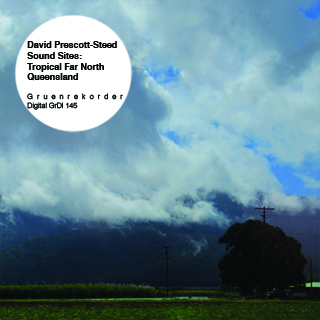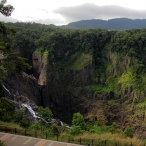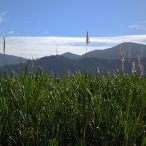
Sound Sites: Tropical Far North Queensland | David Prescott-Steed
GrDl 145 | Gruen Digital > [order]
MP3 & FLAC
Reviews
The Tropical Far North of Queensland is home to the Daintree Forest, a World Heritage region that covers an area of 1,200 km2 and includes 95 kilometres of coastal forest. Home to rare species of birds, bats, frogs, and over 12,000 species of insects, the Daintree comprises Australia’s most diverse ecosystem and, at over 135,000 million years, it is the oldest rainforest on earth.
Crossing the Daintree River by car ferry gets you to Cape Tribulation at the heart of the forest, where there are no phone networks or mainstream electricity. There are no shopping centres or billboards, though visitors will see signs everywhere warning them as to the presence of crocodiles; this is particularly the case around the vast mangroves that lead onto picturesque beaches and views of the Coral Sea.
My wife, 15 month old daughter and I flew up to the tropical north for a ten day break from busy Melbourne. Staying in Glengarry, surrounded by sugar cane crops, we did the rounds of the tourist friendly locations, adding three more human bodies to the amorphous crowds that augmented the already busy sights and soundscapes of the forest with holiday chatter, footsteps on boardwalks, car engines and electric windows, as well as noises emanating from an entire spectrum of cultural paraphernalia. It is not surprising that the most commonly seen devices were digital cameras, operated by different walks of life who were all looking at the same things, from the same designated vantage points, many people appearing to be readying their cameras for the moment when bobbing heads move out of the frame, as if in an attempt to take a photo with nobody in it. At other times, the photographer’s requests for his or her subjects to smile for the camera means that holiday snaps function less as a record of the trip than they do an archive of similarly contrived non-events. My wife and I found ourselves participating in this game and, with it, the collective confirmation that the visual image is the dominant mode of holiday documentation.
I was just another tourist, but used my Sony PCM-D50 to listen to the Daintree forest and its environs as if with the ears of a curious alien. There were no other audio recorders in sight; in this sense, field recording seemed to provide me with a context of authenticity wherein the scopophilic gaze was replaced by an alternative, post-tourist aesthetic. Field recording, in general, is less discerning in that it is increasingly possible to hear sounds that would be inaccessible to the unaided ear; furthermore, the listening experience is defamiliarised when the field recordist listens through headphones to a soundscape during the process of its recording, technologically detached from the majority-tourist experience. There is far more information entering the auditory canals to sort through. I am reminded of R. Murray Schafer’s insight that „The eye points outward; the ear draws inward. It soaks up information….The ear is also an erotic orifice. Listening to beautiful sounds…is like the tongue of a lover in your ear“ (Soundscape, 1977, pp. 11-12). I had never been to Queensland before; exploring it as a sound-tourist, equipped with digitally enhanced hearing, meant that my experience was characterised by an estrangement and artificial intimacy.
Part of my dedication to close, prolonged, listening stems from a culturally-driven sentimentalism around pure ecology. I am not intent on stepping outside of my industrialised idealisms regarding the value of natural environments; such a transgression would make little difference in practice, given that the sheer density and topography of Queensland’s tropical far north makes it inaccessible—protected from people. The tourist’s gaze is always at a distance from the true world of the Daintree, governed by aesthetic criteria and confined to the spaces that are inhabited by other tourists. My decision to concentrate on field recording was a strategy for disrupting the rules of the tourist’s game (looking, but also listening to the lookers), resulting in a kind of audio portrait that is sincere in its offering of an inherently incomplete representation of a remarkable part of the country.
Track list:
01. Ellis Beach Waves at Night / 05:04
02. Four Mile Beach / 09:23
03. Mossman Gorge, Daintree Forest / 02:04
04. Cape Tribulation, Rainforest / 02:03
05. Cape Tribulation, Thornton Beach Carpark /01:01
06. Cape Tribulation, Path, Plants, Birds and Fungus / 02:15
07. Cape Tribulation / 01:06
08. Cape Tribulation, Car Ferry Crossing / 03:52
09. Glengarry Sugar Cane, Mowbray River Road / 03:38
10. Glengarry, Connolly Road, Birds Talking / 02:59
11. Glengarry, Connolly Road, One Wooden Bridge and Two Cars / 00:37
12. Cape Tribulation, Daintree Ferry Crossing and Electric Car Window / 06:31
13. Cape Tribulation, Daintree Ferry Crossing, Steel Wheel and Cable / 02:33
14. Glengarry Chalet Front Porch, Late Evening Rain / 08:38
Excerpts:
14 Tracks (51′49″)
Field Recording Series by Gruenrekorder
Gruenrekorder / Germany / 2014 / GrDl 145 / LC 09488
Łukasz Komła | polyphonia.pl
Nowości płytowe z Gruenrekorder
Właśnie ukazały się cztery nowe albumy w wersji cyfrowej w katalogu oficyny Gruenrekorder. Niemiecka wytwórnia Gruenrekorder to bez wątpienia jeden z najciekawszych europejskich labeli. Wiosną tego roku opisywałem na łamach Polyphonii krążek opublikowany przez Gruenrekorder, a był to album „Mosaïque Mosaic” duetu Christina Kubisch & Eckehard Güther. W ostatnich dniach pojawiły się cztery nowe pozycje, które gorąco polecam.
David Prescott-Steed | Sound Sites: Tropical Far North Queensland
Ten materiał przenosi nas do Australii, gdzie mieszka i tworzy David Prescott-Steed. Artysta wybrał się wraz ze swoją rodziną do lasów Daintree i także innych miejsc znajdujących się w obszarze Queensland. To właśnie tam można podziwiać wyjątkowe gatunki ptaków, nietoperzy, żab czy owadów. Daintree to przykład najstarszych lasów deszczowych na świecie.
link


